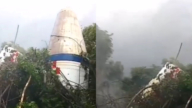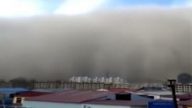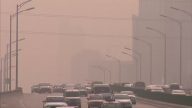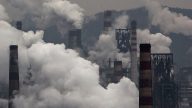【新唐人2011年11月19日讯】北京空气污染的问题存在已久,美国驻华大使馆发布的空气品质检测资料,和北京市环保局公布的空气监测结果严重反差,民众质疑地方政府采用的监测方法和公布的数据。
最近,美国驻北京使领馆测出的空气品质,结果和地方环保局发布的数据相差很大。明明是灰濛濛的天空,看不见蓝天也没有白云,但北京环保监测数据却显示,空气品质达到优良标准。
北京市环保局在前不久发表一份声明指出,今年1月到10月,北京空气品质优良天数达239天。
然而,中共环保部部长周生贤在一次会议上谈到,“人民群众深受污染之害、苦不堪言,而监测数据喜气洋洋、自说自话”。
在发达国家,PM2.5数据是环境控制质量评价的一项重要指标,也是空气质量的一个主要依据。美国使领馆检测北京空气品质使用的是PM2.5标准,而中国的空气品质报告监测的是直径在10微米以下的可吸入颗粒物,就是PM10。
因为PM2.5粒子比PM10更微小,大约是人体头发直径的1/28,因此对人体健康影响更大,尤其是对老人、小孩或易过敏性体质等民众,更具有高度的健康风险。
而《北京日报》11月4号发表一篇文章,题目叫《空气质量数据不该看别人脸色》。内容提到美国驻华使馆检测并公布北京的空气品质,是别有用心。
中国当代作家郑义:“美国人有知情权,他们需要知道他们工作地点,他们到底受到了多大的,这个空气有多么严重的污染,而他们又不是那么太相信中国发布的数据,所以美国大使馆没有办法,他们自己搞一套仪器, 就在美国大使馆网站上面公布,后来很多中国人觉得美国大使馆空气监测数据,跟北京人的感受比较一致,所以这个驻北京美国大使馆的空气监测数据,很受到大家的欢迎。”
中国环境空气质量标准中不含PM2.5,空气质量监测和评价中缺乏对灰霾天气的评估。中国环保部官员11月16号说,这项更为严格的空气质量监测标准目前还无法在全国铺开。
中国当代作家郑义:“这个标准一改变的话,我认为会更准确的反应中国空气污染的程度,对于老百姓,当然是非常好的了,让大家能够知道真实的情况,尤其是跟自己身体健康密切相关的这种真实情况,当然对于各个地方政府来说的话,就不是一件好事。当然他也承认了一个事实,就是”我们北京自己的检测标准跟人家的不一样”,也就是北京官方说的轻度污染,就等于美国大使馆公布的有毒害的污染。”
绿色和平组织中国办公室主任周嵘告诉《美国之音》,中国东部人口密度比较高,污染较为严重的城市地区,仅仅公布PM10的监测结果,是无法说明空气品质到底有多差。
周嵘:“政府更多的时候是会觉得这个数据一拿出来会让自己很丢脸。所以就始终不愿意去公布这些数据。”
中共环保部近期进行的《环境空气品质标准》修订中,对于PM2.5仅设立了参考限值。“编制说明”解释,目前PM2.5污染较重,如果实施PM2.5标准,中国空气品质将大范围超标。
新唐人记者常春、黄容、王明宇采访报导。
Air Pollution Data Conflicts
Beijing’s air pollution problem has long existed.
The U.S. Embassy has issued air quality monitoring data,
which are quite different from the results of the
Beijing Municipal Environmental Protection Bureau.
The public has questioned the monitoring methods used by
the local government and their published data.
Recently, the U.S. embassy posted air quality measured
in Beijing, and the results varied widely from local data.
The sky is obviously gray, it not being possible to see blue sky
or white clouds,
but the Beijing environmental monitoring data
have nevertheless shown that it meets quality standards.
http://big5.china.com.cn/news/txt/2011-11/07/content_23840003.htm
The Beijing Municipal Environmental Protection Bureau said
in a statement released recently, that,
from January to October 2011,
Beijing’s good air quality days were up to 239 days.
However, Zhou Shengxian, Chinese Environmental Protection
Minister , spoke at a meeting saying : “The people are victims of pollution,
and they are not happy about it, but monitoring data
are beaming, telling their own stories."
In developed countries, PM2.5 data is an important indicator
in environmental control quality assessment, and also a major factor in air quality assessment.
Beijing’s U.S. Embassy air quality test used the PM2.5 standard,
while China’s air quality monitoring report is based on a
reparable particulate of less than 10 microns in diameter, PM10.
PM2.5 particles are even smaller than PM10,
and their diameter is about 1 / 28 of human hair, so they have a greater impact on human health,
especially for the elderly, children or others who can easily be
allergic, and have a high degree of health risk.
On November 4, Beijing Daily published an article,
Air Quality Data Should Not Be Seen Publicly,
It said the U.S. Embassy had ulterior motives
when showing air quality detected in Beijing.
Zheng Yi, Chinese contemporary writer says: “Americans
have the right to know, they need to know in their place of work,
how much air pollution they are suffering.
They do not believe much of the data published in China.
The United States Embassy has no other way
but to use their own set of instruments, and to publish the results on their website.
A lot of Chinese people think the U.S. Embassy monitoring data,
are more consistent with their experience of Beijing air quality.
So the U.S. Embassy monitoring data of air quality in Beijing,
is welcomed by everyone."
Air quality standards in China have no PM2.5, and lack
haze assessment in air quality monitoring and evaluation.
Chinese environmental officials said on November 16,
that a more stringent standard for air quality monitoring is difficult to use across the country.
Zheng Yi, Chinese contemporary writer says: “Once the
standard changes, it will reflect China’s air pollution more accurately.
For people, it is very good, letting them know the real situation,
especially the real situation closely related to their own health.
For all local governments, (lack of accuracy) is not a good thing.
They also acknowledged the fact that “our own testing standards
in Beijing are different from those of others”.
That is, the light pollution reported by Beijing officials,
is equivalent to toxic pollution details released in data from the U.S. Embassy."
Zhou Rong, Director of Green Peace China Office told
Voice of America that population density is relatively high in eastern China. In urban areas,
where pollution is more serious, only PM10 monitoring results are released,
which do not explain how bad the air quality is.
Zhou Rong: “The government finds the data shames them,
sand so has always been reluctant to publish these data."
In recent revision by the Chinese Ministry of Environmental
Protection, in amendments relating to Ambient Air Quality Standards,
it only sets up a reference of limits for PM2.5.
It is explained in their instructions that the current pollution is heavy in PM2.5.
If using PM2.5 standard, air quality in China will be out of
standard in large areas.
NTD reporters Chang Chun , Huang Rong and Wang Mingyu































